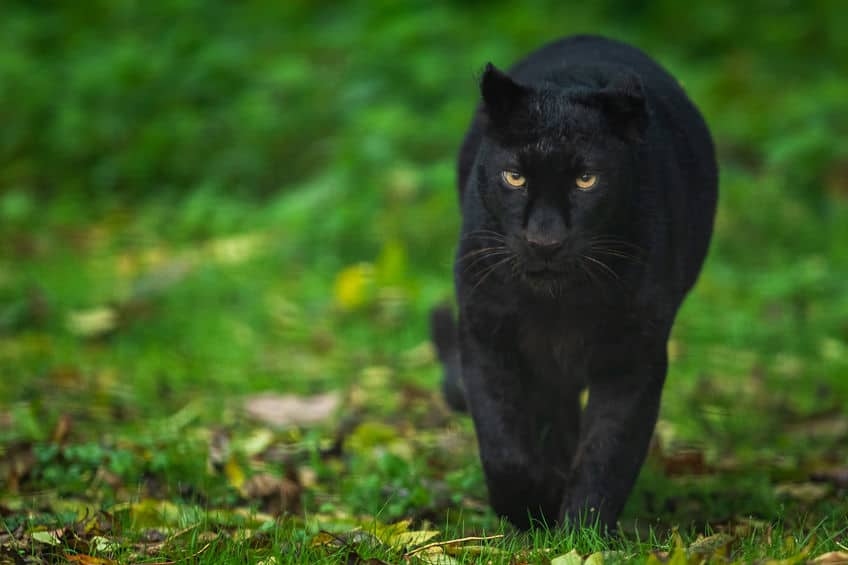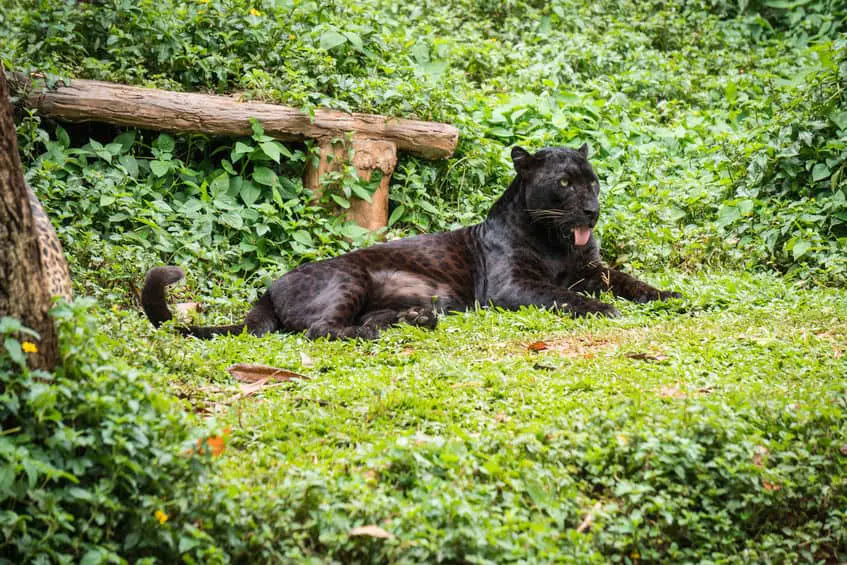
Black leopards are often referred to as black panthers or just panthers. They are extremely rare and beautiful creatures but what exactly are black panthers and are they different from regular leopards?
Black panthers are not a distinct species but rather a genetic variation that can occur in several types of wild cats including leopards. Black leopards can be born in litters where either of the parents is black. The black fur is caused by the production of the dark pigment melanin.
I have done some research about black panthers, specifically black leopards, and collected my findings in this post. Below, I have covered why some leopards are born with black fur, how rare of an occurrence it is, where to find them, and more.
Why are Some Leopards Black?
Black panthers are not a distinct species by themselves but rather a general term used to refer to wild cats that have black skin and fur.
The black color of the skin and fur in panthers is caused by the production of a dark pigment called melanin in the animals’ skin and fur through a process called melanism. Melanism is the opposite of albinism which is a more commonly known phenomenon that causes animals or people to be white or very pale due to the production of melanin being absent in their bodies.
Melanism is a very rare phenomenon that can occur in 13 of the 37 species of wild cats but it is more common in leopards in Africa and Asia and jaguars in Central- and South America than it is in other species of wild cats.
Black leopards are often referred to as black panthers, or just panthers, but are genetically the same as other leopards. They belong to the same species of animals and the only difference is the black skin and fur caused by melanism and the production of melanin.
Leopard cubs are usually born in litters with 1 to 4 cubs (but sometimes up to 6). At birth, the small cubs weigh just around one pound (about half a kilo).
Almost all leopards are born with grey, almost silver-colored, and fuzzy fur all over their body which then turns into the very well-known yellow or orange fur with the very characteristic circular or rosette-shaped, dark markings slowly over the first weeks and months of the leopards’ lives.
On very rare occasions, however, one or some of the leopard cubs in a litter will be born with very dark brown or even black fur. A new litter can have both regularly colored and black cubs. The concentration of melanin can vary greatly between different cubs in a litter and completely black leopards are extremely rare.
Black leopards and leopards with the more regular yellow or orange fur can and do breed with each other since they belong to the same species. Black leopard cubs can occur in a litter if either the mother or the father of the cubs were a black leopard (panther) themself.
Like any other leopard, a black leopard still has the very well-known and characteristic circular or rosette-shaped dark markings in its fur but these markings are much harder to see on panthers since they are almost the same color as the rest of the fur. On the more common (but still quite rare) regular-colored leopards, the markings are much more distinguishable as the color stands out from the yellow or orange fur.
Leopards are very adaptable and can stay in a wide variety of habitats including savannas, rainforests, mountains, and even deserts. Their yellow or orange fur usually provides excellent camouflage in these types of habitats since they blend in with their surroundings very well. Black leopards do not have the same camouflage in these types of habitat, however, having black fur is not necessarily a disadvantage.
Leopards are nocturnal animals which means they are active and hunt mostly at night. Black leopards are particularly well adapted for hunting at night since their black color makes them almost impossible to see in the dark, allowing them to sneak up on unsuspecting prey even more easily than other leopards.
If you are curious about why exactly leopards are nocturnal, check out this post (opens in a new tab) where I have described what advantages leopards gain by hunting and being active at night.
How Rare are Black Leopards?
Black leopards are extremely rare and especially in Africa are they perhaps the most uncommon wildlife sighting of them all.
I have personally seen several leopards in Africa but I have never seen a black leopard or even spoken to anybody who has. In fact, almost no people in the entire world have ever seen a black leopard in Africa.
Black leopards do, however, exist in Africa as we are about to learn.
Regular-colored leopards are already a rather rare sighting and you usually have to be both very patient and very lucky to see them.
The genetic variation that makes leopards black is a very rare occurrence and some studies estimate that around 11% of leopards globally are black although almost all of them are found in Southeast Asia (source).
I have not been able to find specific numbers for how many black leopards are in Africa but I did, however, find out why I was unable to find that information. It is simply because almost no people, ever, see them.
The most recent sighting of a black leopard in Africa happened in 2019 in Kenya. Before that, it had been an unbelievable 110 years since the last black leopard was photographed (and thereby confirmed) in Africa.
One of the reasons why black leopards are so rare is that not only are there almost none of them in the wild in Africa but they also possess all the skills and traits that make leopards some of the most elusive animals in Africa plus they are exceptionally well adapted for hiding in the darkness of the night which is when they are usually active since the dark color of their fur makes them extremely well camouflaged.
While black leopards are extremely rare, as we have already established by now, they may not be as rare as one occurrence every 110 years which the paragraph above insinuates. In fact, people have been reporting sightings of the elusive black leopard for decades but the fact is that none of those reports have been supported by photographic evidence that is strong enough and are therefore not considered to be verified.
Now that we have covered just how extremely rare and elusive black leopards are, let us take a look at where they can actually be found.
Where to See Black Leopards?

Black leopards can be found in areas where other, regular-colored leopards can also be found.
Leopards can be seen in large parts of Africa but primarily in sub-Saharan Africa including popular travel destinations for safaris such as South Africa, Namibia, Kenya, Botswana, and Tanzania as many other African countries. In addition to that, leopards are also found in large parts of Asia, primarily in Southeast Asian countries such as Myanmar, Taiwan, Bangladesh, Sri Lanka, and Vietnam but also in China, Burma, Nepal, and India.
Leopards are very adaptable creatures that can thrive in a wide variety of natural habitats ranging from rainforests to deserts, savannas, and even mountains.
Most black leopards, or panthers, have been observed in moist tropical and subtropical forests.
Almost all verified observations of black leopards have been in Asia but a few of them have also been in Africa, specifically, the ones I mentioned earlier in this post from Kenya in 2019 and the previous one 110 years earlier.
Many more sightings of black leopards in Africa have been reported over the decades but since no photographic evidence that was strong enough has been provided, they have not been counted as qualified, verified observations. These reportings have mostly taken place in Ethiopia and Kenya and since the last verified sighting of a black leopard happened in Kenya, who knows, these other unverified sightings may also be legit.
All in all, black leopards are incredibly rare, even if you count all of the unverified sightings.
Black Leopard Appearance and Anatomy
As we have already learned, black panthers are not a distinct species by themselves but rather belongs to other species of wild cats including leopards, jaguars, cougars, and tigers.
For this reason, the appearance and anatomy of a black leopard are very similar, or even identical, to other leopards even though their skin and fur are black.
Black leopards share all of the qualities in anatomy and appearance with regular-colored leopards. The only difference is that their skin and fur are black. Even the spots are still visible on black leopards although these are much harder to see than on other leopards since their color is often very similar to the dark fur on panthers.
Leopards are the smallest of the famous Big Five which is a group made up of Cape buffalos, Elephants, Leopards, Lions, and Rhinoceroses.
Being the smallest of the big five is, however, in no way a disadvantage for leopards as they are still extremely strong creatures. Pound for pound, leopards are actually the strongest of the five.
How large leopards get depends largely on external factors such as what types of prey animals are available for the leopards to hunt in their territory. On average, leopards weigh between 55 to 65 pounds (around 25 to 30 kg) with the males at the higher end of that range and the females at the lower end, but under the right conditions, leopards can become significantly larger. On rare occasions, leopards have been recorded weighing upwards of 200 pounds (90 kg).
Leopards may be somewhat small, especially compared to certain other large predators in Africa such as lions or hyenas, but they are built in a way that makes them extremely dense, bulky, and strong.
In fact, leopards are so strong that they can carry dead prey animals much larger and heavier than themselves high up into trees using their rock-solid, strong jaw and neck and their incredible climbing skills.
Other than their very well-known, characteristic yellow or orange fur with dark circular or rosette-shaped markings, leopards have strong, big, thick legs and paws, rounded ears, and a long, slightly curved tail which they use for balance.
Other Black Wild Cats
As we have certainly determined by now, black panthers are extremely rare and are not a distinct species by themselves but are rather a genetic variation that can occur in several types of wild cats.
Melanism, which is the process during which melanin, the black pigment, is produced, can occur in several types of wild cats but is more common in leopards and jaguars than in other types of wild cats.
More specifically, black panthers can occur in 13 of the 37 types of wild cats but are most common in leopards in Africa and Asia and Jaguars in Central- and South America.
The term black panther most often refers to these two types of cats (leopards or jaguars), but can also refer to other cats such as cougars, tigers, pumas, lynxes, or bobcats.
If you liked this post and you are interested in learning more about the elusive leopard, I encourage you to take a look at this page (opens in a new tab) where all our posts about leopards can be found.
